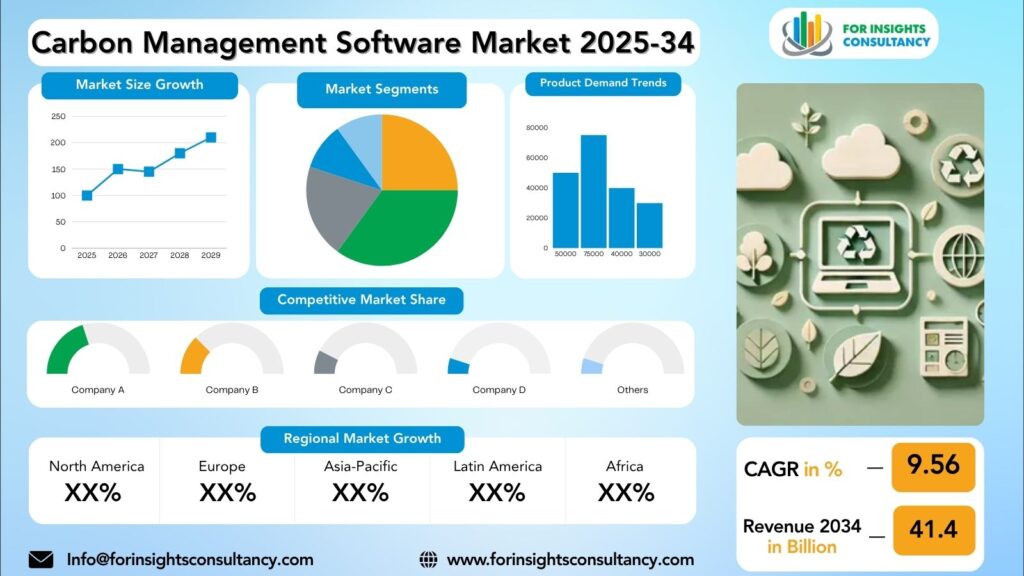
Carbon Management Software Market Size, Trends Analysis Research Report By Offering/Component (Software/Solutions, Services), By Deployment Mode (Cloud-Based, On-Premise), And by Application/Functionality ,By End-User Industry (Individual Consumers, Commercial (Enterprise), Gaming), And By Region Global Market Analysis And Forecast, 2025-2034
Sep-2025 Formats | PDF | Category: IT | Delivery: 24 to 72 Hours
Carbon Management Software Market Is Forecast to Increase from USD 19.1 Billion In 2025 To USD 41.4 Billion By 2034, At A CAGR Of 9.56%.
Carbon Management Software Market: A Comprehensive Overview and Future Developments
The Carbon Management Software Market is experiencing rapid growth, offering comprehensive tools for organizations to manage and reduce their carbon emissions. With a growing focus on sustainability and corporate responsibility, companies are turning to software for tracking and analyzing their environmental impact.
Future developments in the market will likely include real-time data tracking, predictive analytics, and automated reporting capabilities, enabling companies to monitor their carbon footprint and make informed decisions. As regulations around carbon emissions tighten, demand for carbon management software is expected to rise, creating new opportunities for innovation and growth.
The Carbon Management Software Market significantly impacts various industries, including energy, manufacturing, transportation, logistics, and agriculture. Companies use these tools to monitor and optimize their carbon footprint, leading to sustainable operations.
The manufacturing industry improves resource efficiency and reduces emissions, while transportation and logistics companies track emissions and implement strategies to reduce environmental impact. Agriculture manages carbon sequestration and reduces greenhouse gas emissions. The widespread adoption of these tools is crucial for achieving sustainability goals and contributing to a greener future.
Market Dynamics
Growth Drivers
The carbon management software market is experiencing rapid growth due to government regulations, growing awareness of environmental and financial benefits of reducing carbon footprint, and the need for organizations to enhance sustainability efforts and corporate social responsibility initiatives. Advancements in technology, such as artificial intelligence and machine learning, are making it easier for companies to analyze data and make informed decisions to reduce their carbon impact. As a result, the carbon management software market is expected to continue its growth trajectory in the coming years.
Restraints
The carbon management software market is experiencing growth, but it faces challenges such as lack of standardized regulations, high costs for small and medium-sized enterprises, and the complexity of data collection and analysis processes. These factors hinder the implementation of consistent carbon management strategies and make it difficult for companies to accurately measure and report their carbon footprint. To overcome these obstacles, collaboration between businesses, governments, and software developers is needed to create more accessible and cost-effective solutions for carbon management.
Opportunities
The Carbon Management Software Market presents significant opportunities for organizations aiming to minimize their carbon footprints and meet sustainability objectives. The increasing pressure from regulations and consumer expectations for environmentally responsible practices makes this sector attractive for businesses that can leverage specialized software solutions. These tools facilitate the monitoring, tracking, and reporting of greenhouse gas emissions, providing a comprehensive carbon management framework. They empower organizations to pinpoint improvement areas, establish emission reduction targets, and execute strategies to lessen their environmental impact. By investing in carbon management software, companies not only ensure compliance with regulations but also bolster their reputation as responsible corporate citizens dedicated to environmental stewardship. As the market progresses, it promises substantial avenues for innovation and growth, positioning organizations to enhance their sustainability efforts effectively.
Challenges
The Carbon Management Software Market is currently confronted with significant challenges that impact its growth and wider adoption. A primary issue is the absence of standardized methodologies and tools for the measurement and reporting of carbon emissions. This lack of standardization often results in inconsistent data, making it difficult for organizations to accurately monitor their carbon footprints. Furthermore, the substantial upfront costs of implementing carbon management software pose a considerable barrier to many companies, particularly small and medium-sized enterprises (SMEs), which may lack the financial resources to invest in such technologies.
Another complication arises from the intricate nature of carbon accounting regulations and requirements, which differ across regions and industries. This variability can lead to confusion and compliance difficulties for organizations aiming to lower their carbon emissions. However, despite these hurdles, there is a growing emphasis on sustainability and environmental responsibility, which is spurring an increasing demand for carbon management software within the market. This trend indicates a potential for growth and innovation, as companies seek solutions that align with evolving sustainability goals and regulatory pressures.
Carbon Management Software Market Top Companies Covered In This Report:
Evaluate The Strategic Positioning And Innovation Pipelines Of Leading Market Companies-From Multinational Enterprises To Disruptive Regional Firms. Understand How Key Players Are Innovating, Expanding, And Capturing Value, And Use Competitive Benchmarks To Plan Your Next Move.
- Carbon Direct Inc.
- Apave Group
- CarbonetiX
- Cority Software Inc.
- Cozero GmbH
- Emex Software Ltd.
- ENGIE SA
- Iconic Air Inc.
- International Business Machines Corp.
- Microsoft Corp.
- Newco Emitwise Ltd
- Ecologi
- North Star Carbon Management Inc
- Persefoni AI Inc.
- Sage Group Plc
- Salesforce Inc.
- SAP SE
- Schneider Electric SE
- Simble Solutions Ltd.
- Sphera Solutions Inc.
- Wolters Kluwer NV
- Workiva Inc
Carbon Management Software Market Company News
In March 2024, GE Vernova debuted its CERius carbon management software, leveraging AI/ML for energy management in power plants.
In May 2025, Watershed introduced Open CEDA, a free global emissions database covering 148 countries and 400 industries to address critical data gaps.
In August 2025, Position Green acquired Morescope, expanding its capabilities with carbon measurement and modeling tools.
In March 2025, Apave Group added Aktio’s carbon accounting tools to its risk and compliance services.
In February 2025, Ecologi acquired Net Zero Now to combine climate project platforms with sector-specific carbon measurement, especially for SMEs.
In April 2024, climate tech startup LEVELUP acquired Zevero, merging the businesses under the Zevero brand for European expansion.
Segmented View Of The Industry:
The Carbon Management Software Market Is Mapped Through A Multidimensional Lens-Tracking Shifts Across Product Type, Applications, And Geographic Regions. This Segmented Approach Enables Businesses To Localize Their Growth Plans And Align Offerings With The Most Profitable Demand Centers.
Segmentation By Offering/Component
- Software/Solutions
- Services
Segmentation By Deployment Mode
- Cloud-Based (Dominant)
- On-Premise
Segmentation By Application/Functionality
- Greenhouse Gas (GHG) Management
- Energy Management
- Compliance and Reporting
- Sustainability and ESG Management
Segmentation By End-User Industry
- Manufacturing
- Energy & Utilities
- IT & Telecom
- Transportation & Logistics
- BFSI (Banking, Financial Services, and Insurance)
- Construction & Infrastructure
Global Geographic Coverage:
Based On Recent Market Analysis, North America Is The Largest And Most Mature Market For Very Small Aperture Terminals (Vsat). Its Leading Position Is Driven By Significant Investments In Defense And Government Sectors And A Well-Established Telecommunications Infrastructure.
The Report Provides In-Depth Qualitative And Quantitative Data On The Carbon Management Software Market For All Of The Regions And Countries Listed Below:
North America
The Carbon Management Software Market in North America is experiencing significant growth, primarily due to escalating regulatory pressures and proactive corporate sustainability measures. The United States emerges as the leading contributor to this market, fueled by stringent emission regulations and an increased uptake of carbon management solutions by businesses committed to minimizing their carbon output. The presence of an advanced technological framework and a substantial industrial sector in the U.S. further facilitate the widespread implementation of carbon management software across various industries.
In addition, Canada plays a crucial role in this market, particularly by targeting greenhouse gas emissions reductions in sectors such as oil and gas, mining, and transportation. The Canadian government’s dedication to meeting carbon reduction objectives has prompted a notable rise in the adoption of carbon management software among local enterprises.
Overall, North America stands as a pivotal region for the global carbon management software market’s expansion, with both the United States and Canada significantly influencing the advancement of sustainable practices and environmental responsibility throughout the region.
Europe
Europe plays a pivotal role in the global Carbon Management Software Market, with significant contributions from several key countries. Germany, recognized as the largest economy in Europe, has been a leader in implementing carbon management software solutions. This initiative is primarily driven by the country’s strong commitment to sustainability and compliance with rigorous environmental regulations, resulting in increased demand for sophisticated carbon management tools designed to minimize emissions.
France also stands out as a major player in this market, largely due to its ambitious carbon reduction targets. The French government’s focus on transitioning to a low-carbon economy has fostered an environment ripe for the adoption of innovative software solutions aimed at effectively monitoring and managing carbon emissions. This commitment not only enhances France’s market position but also opens up attractive opportunities for software providers in the carbon management space.
The United Kingdom further complements the European market landscape, leading in the demand for carbon management software. The UK has established stringent carbon reporting requirements and a steadfast commitment to achieving net-zero emissions. These factors have significantly boosted the need for advanced software solutions that enable businesses to monitor and effectively reduce their carbon footprints.
In conclusion, the European region exhibits a vibrant and diverse market for carbon management software, shaped by the proactive efforts of nations like Germany, France, and the UK. These countries are united in their goals to combat climate change and advance towards carbon neutrality, driving innovation and growth within this essential sector.
Asia Pacific
The Carbon Management Software Market in the Asia Pacific region is experiencing notable growth primarily fueled by escalating environmental concerns and the implementation of stringent regulations across various countries. In China, the expansion of this market is significantly influenced by the government’s commitment to decreasing carbon emissions and fostering sustainable development initiatives. India’s carbon management software market is rapidly evolving as businesses prioritize the enhancement of their environmental performance in alignment with existing carbon regulations, highlighting a proactive approach to sustainability.
Japan has emerged as a vital player in this sector, driven by a robust focus on technology and innovation aimed at minimizing carbon footprints. South Korea also exhibits a flourishing market, where industries are increasingly adopting green practices and investing in environmentally friendly solutions, showcasing a shift towards sustainable operational methods. Meanwhile, Australia is gaining prominence within this market, with a rise in public awareness regarding climate change prompting the adoption of carbon management software as a critical business practice.
In summary, the Asia Pacific region stands out as a land of significant opportunity for enterprises engaged in the carbon management software market. Each nation within this region presents its own set of unique challenges and opportunities, creating a diverse landscape for growth in this increasingly vital domain of environmental management.
Middle East and Africa
The Carbon Management Software Market in the Middle East and Africa is experiencing substantial growth, primarily fueled by a heightened focus on sustainability and environmental regulations. In the Middle East, countries such as Saudi Arabia, the United Arab Emirates (UAE), and Qatar are at the forefront of adopting carbon management software. These nations are committed to reducing their carbon footprints and aligning with international standards, making significant investments in renewable energy initiatives and establishing strict emission reduction targets. This approach not only addresses environmental concerns but also enhances their competitiveness on a global scale.
Conversely, in Africa, countries including South Africa, Kenya, and Nigeria are increasingly leveraging carbon management software to effectively monitor and control greenhouse gas emissions. South Africa, given its heavy reliance on coal for energy, is particularly focused on transitioning to more sustainable energy sources while implementing carbon pricing mechanisms. Similarly, Kenya and Nigeria are intensifying their efforts to combat climate change and are actively seeking technological solutions to fulfill their sustainability objectives.
In summary, both the Middle East and Africa exhibit a promising landscape for carbon management software providers, as government bodies and industries alike recognize the critical necessity of addressing climate change and minimizing their carbon footprints. This recognition is expected to continue driving demand for advanced carbon management solutions, making the region an attractive market for vendors in this field.
Reasons To Buy:
- The Research Would Help Top Administration/Policymakers/Professionals/Product Advancements/Sales Managers And Stakeholders In This Market In The Following Ways.
- The Report Provides Carbon Management Software Market Revenues At The Worldwide, Regional, And Country Levels With A Complete Analysis To 2034 Permitting Companies To Analyze Their Market Share And Analyze Projections, And Find New Markets To Aim For.
- To Understand The Most Affecting Driving And Restraining Forces In The Market And Their Impact On The Global Market.
- Major Changes And Assessment In Market Dynamics And Developments.
- The Objective Of The Carbon Management Software Market Report Is To Identify New Business Opportunities Using Quantitative Market Forecasts.
- Formulate Sales And Marketing Strategies By Gaining An Understanding Of Competitors, Their Positioning, And Strengths & Weaknesses.
Faq – What Global Leaders Are Asking
What Is The Growth Prospect For The Carbon Management Software Market By 2034?
Carbon Management Software Market Is Expected To Achieve A Stable Growth Rate With A Compound Annual Growth Rate (CAGR) Of About 9.56% From 2025 Through 2034.
What Is Driving The Growth Of The Carbon Management Software Market?
The growth is primarily driven by strict global regulations (like the EU’s CSRD and potential SEC rules) that mandate transparent emissions reporting.
This regulatory pressure is compounded by corporate net-zero commitments and investor demands for verifiable ESG data, necessitating advanced software for complex Scope 3 tracking.
Who Are The Key Players In The Carbon Management Software Market, And What Are Their Market Shares?
The Carbon Management Software Market Includes Major Companies Like Carbon Direct Inc., Apave Group, CarbonetiX, Cority Software Inc., Cozero GmbH, Emex Software Ltd., ENGIE SA, Iconic Air Inc., International Business Machines Corp., Microsoft Corp., Newco Emitwise Ltd, Ecologi, North Star Carbon Management Inc, Persefoni AI Inc., Sage Group Plc, Salesforce Inc., SAP SE, Schneider Electric SE, Simble Solutions Ltd., Sphera Solutions Inc., Wolters Kluwer NV, Workiva Inc, Others.
Specific Market Share Data Is Not Publicly Available And Is Typically Provided In Detailed, Proprietary Market Research Reports.
Which Regions Are Leading The Carbon Management Software Market Growth?
North America currently holds the largest market share due to stringent environmental regulations and early adoption. However, the Asia Pacific region is anticipated to be the fastest-growing market, driven by rapid industrial expansion and new government sustainability initiatives.
Customization: We Can Provide Following Things
1) On Market More Company Profiles (Competitors)
2) Data About Particular Country Or Region
3) We Will Incorporate The Same With No Additional Cost (Post Conducting Feasibility).
Any Requirement Contact Us: Https://Www.Forinsightsconsultancy.Com/Contact-Us/
Table of Contents
For TOC Contact us: https://forinsightsconsultancy.com/contact-us/







